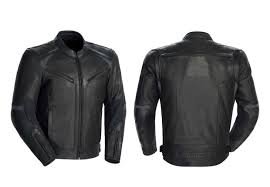best gore tex motorcycle jacket 2012

Leather riding gear used to be pretty straightforward … limited even. You bought the best you could afford and made sure it fit correctly. You chose classic black or some ridiculous rainbows of colors on one piece of gear. If you were going to ride in hot weather, you got perforated leather, or at least well-vented gear—or you accepted that you would be sweating a lot. In recent years, though, that’s changed—leather gear has gone high, or at least higher tech. Most notably, Aerostich has their Transit jacket and pants, which combine Gore-Tex and leather, marrying the benefits of both textile and leather. That stuff is not cheap, however, so when I heard about Tourmaster’s Element jacket and pants, I was very interested. Sure, it’s not Gold-tex, excuse me, Gore-Tex, but it’s also under $400. Here’s the deal: Tourmaster’s Element Cooling Leather Jacket doesn’t’ claim to be an every season, rain or shine, sleet or snow, kind of jacket. It does, however, claim to handle both ends of the weather spectrum, with TFL cooling leather (more on what that is in just a moment) and some level of wet weather protection, thanks to waterproof leather and water resistant construction.

First impressions: right off the hanger, brand spankin’ new, the Element’s leather is very soft, almost luxurious. It’s so soft that I was checking the paperwork to make sure I didn’t end up with some kind of synthetic leather jacket. Nope—the 1.1 to 1.2 mm cowhide is just soft. The design of the Element is simple … near timeless. Sure, it’s not as classic as an authentic vintage find—it does have slightly more modern lines, vents in the shoulders, and (gasp!) stretch Kevlar panels in the elbows. It even has little bits of black reflective material here and there to improve visibility. But all these modern touches fade to black, as do the subtle brand badges, and the Element presents itself very much like a classic motorcycle jacket. Speaking of cool, what the hell is TFL cooling leather? Tourmaster says the TFL treatment “reflects UV rays, resulting in the temperature of the leather surface being reduced by up to 15%.” We’re in the Bay Area, where riders start complaining about “too hot” at what, 65 degrees?

It’s tough to test a cooling treatment here. I did ride up to Sacramento in the jacket a couple times, where temperatures actually get hot.
1000cc bike for sale in saThe Element seemed genuinely cooler in the springtime sun than I was expecting.
motorcycle paint shops oahu Tourmaster doesn’t say much about the waterproofing on the leather—it doesn’t have a snazzy name like TFL.
motorcycle tires mcallen txBut I rode in some light rain, which will probably be the last water we’ll see in California until 2018, the way things are going, and I stayed dry.
honda motorcycle dealer flint miIt doesn’t have the same level of flaps and waterproof zippers that a truly waterproof garment would have, but it seems it’d do fine if you encounter some rain on a trip and don’t have raingear in your panniers.

If you’re headed into a real storm, though, I imagine proper waterproof gear would be in order. The Element has the usual amenities you’d expect of a ~$400 jacket: CE-approved (whatever that means these days) elbow and shoulder pads, a back protector, and a removable quilted liner. There are adjustment straps at the waist, vents at the shoulders and back for flow-through ventilation, hand-warmer pockets and two pockets on the chest that can also serve as vents. My only gripe is that the sleeves don’t have much in the way of adjustment at the wrist—just zippers. So they work just fine with my Held Rodney summer gloves, which have a very short, thin cuff. But they’re too tight for my Helimots to go inside, and at the same time, just bulky enough to be kinda tricky to get a gauntleted glove like my Helimots over. The Element is probably the perfect jacket for someone who lives in Tennessee or other places where the weather swings back and forth between hot and humid to hot and actually raining.

Here in California, the utility of a leather jacket that purports to keep you cooler, but is also waterproof, is slightly reduced. But it’s still a great jacket—conservative-looking and generally handsome, comfortable without any break-in, and while not cheap, not exactly expensive. So if you’re doing a fly and ride on the Tail of the Dragon, or just want a nice leather jacket, check out the Element. This article is copyright CityBike Magazine – used with permission. You can follow any responses to this entry through the RSS 2.0 feed. Both comments and pings are currently closed. We’ve got our hands full at the moment but we should be up and moving shortly.This page will automatically refresh and bring you into the website as soon as we can handle it. or reach us by phone. 電話 : 受付時間 9:00-17:00(日・祝日も営業)Any domestic order (lower 48 United States) over $40.00 ships for free! If your item isn't over $40 but your total cart value is, you'll qualify for free shipping as well!

For more information on our Shipping Policies, click here. Here at STG we want any return or exchange to be quick and pain-free. You can contact anyone here to expedite your return or exchange and we'll make sure it's handled ASAP. For more information on our policies, click here. Find a better price? If you have we will match it! Call us at 888.784.4327 or submit a request here and our team will make it happen. *Some exclusions may apply. Our Customer Rewards Program leads the industry! Earn 5% STG CASH Rewards on every dollar you spend with us that is credited to your account automatically (max $30 per order). Select Brands are excluded, please Click Here for more details.Cuben fiber is increasingly appearing in high-end ultralight gear, from the featherweight tarps and shelters of Hyperlite Mountain Gear to gram-counting stuff sacks from Zpacks to the just-announced 27-ounce Sierra Deisgns Mojo UFO two-person tent. But what exactly is cuben fiber anyways? And why does it cost so much?

I’m not kidding about the price. The stuff sacks from Zpacks are your most reasonable option for getting your hands on this space-age material. A 0.3-ounce medium stuff sack will run you only $15.95. Produced and marketed by the Cubic Tech Corporation in its CTF3 product line, cuben fiber is a non-woven fabric that sandwiches Dyneema fibers between two layers of composite laminate material. (With a strength up to 15 times that of steel, Dyneema is dubbed “the world’s strongest fiber.”) The resulting fabric is extremely strong, waterproof, and highly tear-resistant. Cuben fiber first appeared in 1992 in the America’s Cup sailing race, where it was used as the sail material in the winning U.S. boat, America3. (Cubic Tech was actually acquired by sail maker North Sails in 2007.) Today cuben fiber is available in a range of thicknesses and weights—the lightest version weighs a mere 0.4 ounce per square meter—as well as a variety of colors. Compare that to ultralight 15-denier silnylon, which weighs in at nearly three times that.